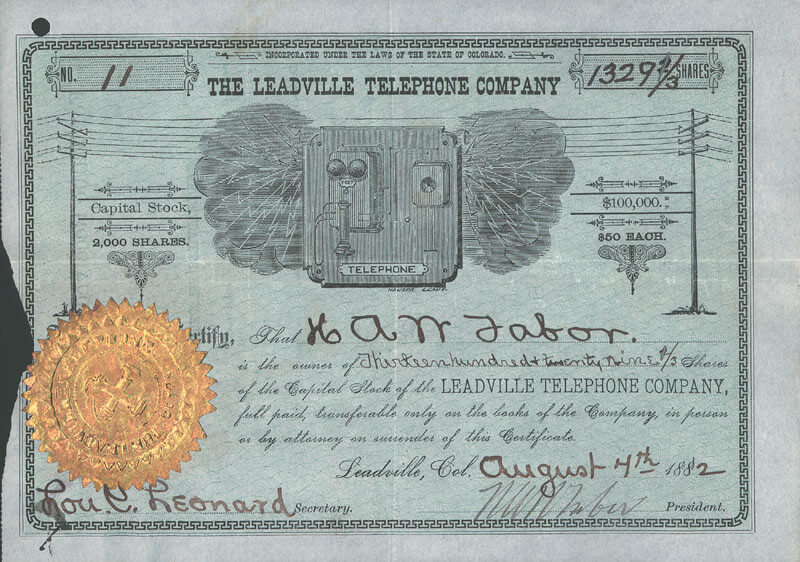Telecommunications History Group Resources
Telephone Company Histories
Leadville Telephone Company
 Location: Leadville, CO
Location: Leadville, CO
Started: 1882
Sold to/Ended: Purchased by Colorado Telephone Co., 1888
History: Between them, Horace Tabor and his first wife, Augusta, owned 2,660 shares of the 2,672 shares of stock issued by the Leadville company. The company seal featuring embossed, crossed long-pole telephone receivers and the certificate’s vignette of a long pole receiver on a bell/magneto box with a Blake transmitter and telephone lines are unique first-rate, custom-designed items which is typical for a Tabor endeavor.
When the beautiful Baby Doe came into his life, Tabor gave half of his holdings, including the Leadville Telephone Company, to Augusta in a divorce settlement. Augusta took the money and moved to California.
Tabor married Baby Doe in the White House (he was a U.S. Senator from Colorado). They moved to Denver and lived a lavish life as exemplified by the sumptuous Tabor Opera House. The Silver Panic of 1893 caused Tabor to lose nearly all of his fortune. In the end, he died nearly a pauper, holding a patronage job as the Denver postmaster. Legend says that with his last breath, he told Baby Doe, “Never give up the Matchless,” his original Leadville mine. Baby Doe Tabor died 35 years later, a lonely recluse living in a cabin at the abandoned Matchless mine. Augusta died a millionaire in California.
The Leadville Telephone Company played an important role in telephone history. After buying the Leadville company in 1888, Colorado Telephone decided to connect Colorado’s two largest cities, Leadville and Denver. It was no small venture.
The connecting telephone toll line had to go over the 13,180-foot Mosquito Pass. A telephone line had never been built at this altitude, and the first three attempts were failures. The lightweight poles, which were the only poles mules and horses could carry up the mountain, just couldn’t hold up under the wind, ice, snow and rockslides that occur constantly at that altitude. The toll line was finally “installed” by laying insulated wire on the ground. The result was functional, but not very satisfactory.
As a result of the “Leadville Line” experience, telephone engineers came up with the heavy-duty “H” fixture telephone pole configuration it took to carry telephone wires over the Rockies. The “H” fixture became the unique recognition sign of the Colorado Telephone Company and its successor, Mountain States Telephone & Telegraph Co. (as can be seen in the Allen True mural featured in the outside lobby of the MST&T Headquarters Building in Denver, and the MST&T stock certificate vignette).
